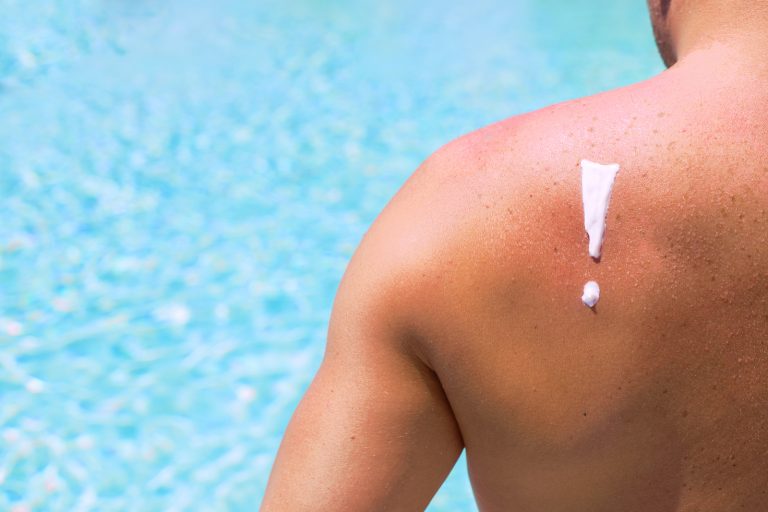Living in Arizona you are bound to get at least one sunburn in your lifetime.

It is important to take precautions to prevent this from happening, as too much sun exposure causes your skin to age more quickly and could cause more serious ailments like skin cancer. According to the Skin Cancer Foundation, children are especially at risk: One blistering sunburn in childhood or adolescence more than doubles a person’s chances of developing melanoma later in life.
Mistakes happen, however, and despite your best efforts you may find yourself at home with a sunburn. There are things you can do to take the edge off and to lessen the impact of the burn, and we have listed some of them for you.
Sunburn Care for Adults
Severe, and blistering burns can make you ill, and you should probably seek treatment from a doctor. For milder burns, follow these steps from the Skin Cancer Foundation to relieve discomfort:
- If you feel the tale-tell tingling of a burn or see any sign of skin reddening on the skin, get out of the sun and begin treatment. A sunburn can sneak up on us and they can take up to four to six hours for symptoms to appear. A touch of pink at the lake or pool could turn into a huge problem later.
- Take in extra fluids. Any burn draws fluid to the skin surface and away from the rest of the body and can cause you to become dehydrated. Replace body fluids by drinking water, juice or sports drinks.
- To get some relief, take ibuprofen. It will cut back on the swelling and redness that may occur and could possibly help prevent some long-term skin damage. It will also help treat the headaches, slight fevers, and chills that are common side effects of sunburns. Acetaminophens will help to treat the pain, but they do not have the same anti-inflammatory effect.
- Cool and soothe your skin by taking a bath in tepid water.
- Keep the area moisturized by adding a light moisturizer, like Aloe Vera, to the skin. Having the aloe chilled in the refrigerator before application is very soothing. A moisturizer with vitamin C and/or vitamin E is another good option. Moisturize frequently to make peeling and flaking less noticeable. Never peel, pick or scrub at the affected skin, and never break any blisters you may have.
- Until your burn has healed completely it is best not to expose it to more sun. If you have to go outside keep the affected area covered and stay in the shade.
Sunburn Care for Children
According to the Skin Cancer Foundation, young skin heals faster than older skin, but it is also less able to protect itself from injury, including injury from the sun. Babies that are under six months in age should not be exposed to the sun. Babies that are older than six months should be protected from the sun and wear UV-blocking sunglasses to protect their eyes. If your child becomes sunburned, the Skin Cancer Foundation offers this advice:
- For babies under a year in age, a sunburn should be treated like an emergency, and you should call your child’s doctor immediately.
- Children one year or older should see doctor if they have severe pain, blistering, lethargy or a fever of 101 F or higher with their sunburn.
- Keep your child hydrated with juice and water to replace any body fluids they may lose, especially if they are not urinating regularly.
- If they have a fever of 101 F or higher give them acetaminophen for some relief.
- The American Academy of Dermatology suggest using a cool compress on the affected area for 10 to 15minutes a day for some relief for your child. This could help keep them from rubbing, scratching and picking at the affected area.
- Cool their skin in a tepid bath.
- Apply Aloe Vera over the affected area. Dab the Aloe Vera on, never rub. Be careful not to use lotions or creams that have any of these things listed in the ingredients: petroleum, benzocaine, or lidocaine as they can irritate a child’s sensitive skin.
- Keep your child from breaking blisters to help prevent infection and scaring.
- If your child feels dizzy, weak, cold, or sick to their stomach you should take them to the doctor.
- Keep your child out of the sun until the burn has completely healed.
The best thing you can do for your skin and your children’s skin is to not burn at all, use sunscreen, cover up with clothing and hats and avoid the sun as much as possible between 10 AM and 4 PM. The Skin Cancer Foundation says to remember these easy steps when you apply your sunscreen.
- Apply one ounce of sunscreen or a golf ball-sized amount at every application.
- Reapply sunscreen every two hours, or after swimming or sweating a lot.
Stay covered, stay safe!


2 Responses to How to Care For Your Skin after a Sunburn